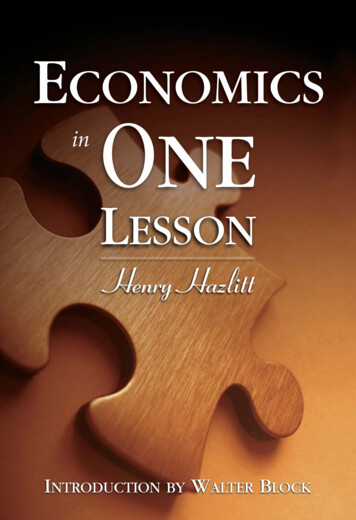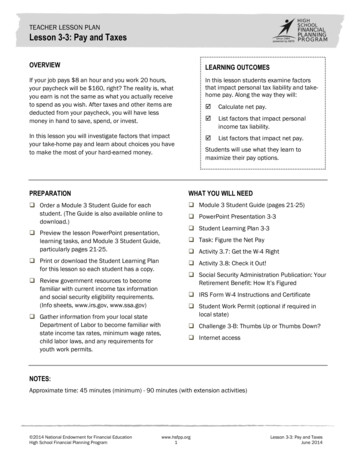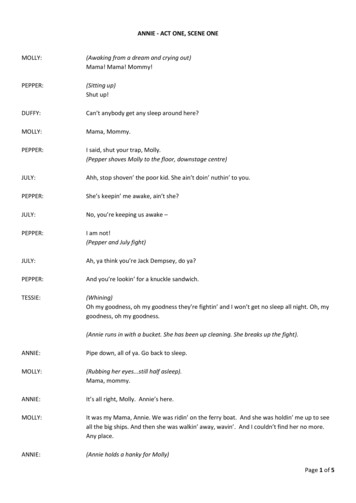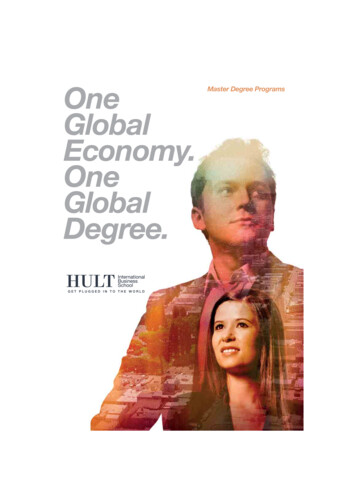
Transcription
EconOne Prf2 Q5 to client.qxd3/3/20088:42 AMPage iEconomics in One Lesson
EconOne Prf2 Q5 to client.qxd3/3/20088:42 AMPage iiThe Ludwig von Mises Institute dedicates this volume to all of itsgenerous donors and wishes to thank these Patrons, in particular:Mr. and Mrs. Brantley I. NewsomCarl A. Davis; David Keeler; Chris J. RuferRobert G. Beard, Jr.; Mr. and Mrs. J. Robert Bost; Mary E. Braum;Mr. and Mrs. Jeremy S. Davis; Richard J. Kossmann, M.D.;Hunter Lewis; Arthur L. Loeb; Mr. and Mrs. Peter K. Martin;Mr. and Mrs. William W. Massey, Jr.; Wiley L. Mossy, Jr.;James M. Rodney; Ann V. Rogers; Sheldon Rose; top dog ;William P. Weidner; Mr. and Mrs. Walter Woodul IIIRoss K. Anderson; Dr. Vern S. Boddicker; John Hamilton Bolstad;John E. Burgess; in memory of A.T. (Norge) Cook;Mr. and Mrs. George Crispin; Kerry E. Cutter;Mr. and Mrs. Willard Fischer; James and Dannell Fogal;Larry R. Gies; Bettina Bien Greaves; Charles C. Groff;Keith M. Harnish; Dr. Frederic Herman; Doyle P. Jones;Warner Knight; David M. Kramer; Jim Kuden; John R. Lee;Ronald Mandle; Joseph Edward Paul Melville;Robert A. Moore; Francis M. Powers, Jr., M.D.;Robert M. Renner; Michael Robb;Mr. and Mrs. Joseph P. Schirrick; Conrad Schneiker;Ernesto Selman; Norman K. Singleton;Mr. and Mrs. Thomas W. Singleton;Henri Etel Skinner; Mr. and Mrs. Byron L. Stoeser;Charles A. Strong; Edward Van Drunen
EconOne Prf2 Q5 to client.qxd3/3/20088:42 AMPage iiiEconomics in One LessonHenry HazlittIntroduction by Walter BlockLudwig von Mises InstituteAuburn, Alabama
EconOne Prf2 Q5 to client.qxd3/3/20088:42 AMPage ivCopyright 1946 by Harper & BrothersIntroduction copyright 2008 by the Ludwig von Mises InstituteThe Ludwig von Mises Institute thanks Three Rivers Press for permission to reproduce the first edition of Economics in One Lesson.All rights reserved. No part of this book may be reproduced or transmitted in anyform or by any means, electronic or mechanical, including photocopying, recording,or by any information storage and retrieval system, without permission in writingfrom the publisher.Originally published in the United States in hardcover by Harper & Brothers Publishers, New York, in 1946. Subsequently a revised edition was published in softcoverby Three Rivers Press, an imprint of the Crown Publishing Group, a division of Random House, Inc., New York, in 1988. This edition is published by arrangement withThree Rivers Press.Produced and published by the Ludwig von Mises Institute, 518 West MagnoliaAvenue, Auburn, Alabama 36832 USA. Mises.org.ISBN: 978-1-933550-21-3Printed in China
EconOne Prf2 Q5 to client.qxd3/3/20088:42 AMPage vContentsIntroduction by Walter Block . . . . . . . . . . . . . . . . . . . . . . . . . . . . .viiPreface to the First Edition by Henry Hazlitt . . . . . . . . . . . . . . . .xiPart One: The Lesson . . . . . . . . . . . . . . . . . . . . . . . . . . . . . . . . . . . .11The Lesson . . . . . . . . . . . . . . . . . . . . . . . . . . . . . . . . . . . . .3Part Two: The Lesson Applied . . . . . . . . . . . . . . . . . . . . . . . . . . . . .9234567891011121314The Broken Window . . . . . . . . . . . . . . . . . . . . . . . . . . . .11The Blessings of Destruction . . . . . . . . . . . . . . . . . . . . .13Public Works Mean Taxes . . . . . . . . . . . . . . . . . . . . . . . .17Taxes Discourage Production . . . . . . . . . . . . . . . . . . . . .23Credit Diverts Production . . . . . . . . . . . . . . . . . . . . . . . .25The Curse of Machinery . . . . . . . . . . . . . . . . . . . . . . . . .33Spread-the-Work Schemes . . . . . . . . . . . . . . . . . . . . . . . .45Disbanding Troops and Bureaucrats . . . . . . . . . . . . . . . .51The Fetish of Full Employment . . . . . . . . . . . . . . . . . . .55Who’s “Protected” by Tariffs? . . . . . . . . . . . . . . . . . . . . .59The Drive for Exports . . . . . . . . . . . . . . . . . . . . . . . . . . .69“Parity” Prices . . . . . . . . . . . . . . . . . . . . . . . . . . . . . . . . . .75Saving the X Industry . . . . . . . . . . . . . . . . . . . . . . . . . . . .83v
EconOne Prf2 Q5 to client.qxd3/3/20088:42 AMPage vivi Economics in One Lesson151617181920212223How the Price System Works . . . . . . . . . . . . . . . . . . . . . .89“Stabilizing” Commodities . . . . . . . . . . . . . . . . . . . . . . . .97Government Price-Fixing . . . . . . . . . . . . . . . . . . . . . . . .105Minimum Wage Laws . . . . . . . . . . . . . . . . . . . . . . . . . . .115Do Unions Really Raise Wages? . . . . . . . . . . . . . . . . . . .121“Enough to Buy Back the Product” . . . . . . . . . . . . . . .133The Function of Profits . . . . . . . . . . . . . . . . . . . . . . . . .141The Mirage of Inflation . . . . . . . . . . . . . . . . . . . . . . . . .145The Assault on Saving . . . . . . . . . . . . . . . . . . . . . . . . . .159Part Three: The Lesson Restated . . . . . . . . . . . . . . . . . . . . . . . . .17324The Lesson Restated . . . . . . . . . . . . . . . . . . . . . . . . . . . .175
EconOne Prf2 Q5 to client.qxd3/3/20088:42 AMPage viiIntroduction to the 2007 Edition ofEconomics in One LessonWriting this introduction is a labor of love for me. You know howwomen sometimes say to each other “This dress is you! ” Well,this book is me! This was the first book on economics that just jumpedout and grabbed me. I had read a few before, but they were boring.Very boring. Did I mention boring? In sharp contrast, Economics in OneLesson grabbed me by the neck and never ever let me go. I first read itin 1963. I don’t know how many times I have reread it since then.Maybe, a half-dozen times in its entirety, and scores of times, partially,since I always use it whenever I teach introductory economics courses.I am still amazed at its freshness. Although the first editionappeared in 1946, apart from a mere few words in it (for example, itholds up to ridicule the economic theories of Eleanor Roosevelt, aboutwhich more below) its chapter headings appear as if they were rippedfrom today’s headlines. Unless I greatly miss my guess, this will still betrue in another 60 years from now, namely in 2068. Talk about a bookfor the ages. Other books on Austrian economics, too, are classics, andwill be read as long as man is still interested in the subject. Mises’sHuman Action and Rothbard’s Man, Economy, and State come to mind inthis regard. But those are epic tomes, numbering in the hundreds ofpages. This little book of Hazlitt’s is merely an introduction, written,specifically, for the beginner. I wonder of how many introductions to avii
EconOne Prf2 Q5 to client.qxd3/3/20088:42 AMPage viiiviii Economics in One Lessonsubject it can be truly said that they are classics? I would wager very,very few, if any at all.There is nothing that pleases a teacher more than when thatexpression of understanding lights up a student’s face. The cartoonsdepict this phenomenon in the form of a light bulb appearing rightabove the depiction of the character. Well, let me tell you: I have gotten more “ahas” out of introductory students who have read thisbook than from any other. I warrant that there have been more conversions to the free market philosophy from this one economics bookthan, perhaps, from all others put together. It is just that stupendous.The only thing I regret in this regard is that never again will I read thisbook for the first time. That, gentle reader, is a privilege I greatly envyyou for having.A word about style. The content, here, we can take for granted.But the number of economists who could really write can be countedupon one’s fingers, but Hazlitt is certainly one of them. His verbiagefairly leaps off the page, grabbing you by the neck. In fact, I now venture a very minor “criticism”: the author of this book is so elegant awordsmith that sometimes, rarely, I find myself so marveling at hispresentation, that I take my eye off the “ball” of the underlying economics message.But enough of my personal slavering, drooling appreciation for Economics in One Lesson. Let us now get down to some specifics. The core ofthis book is, surely, the lesson: “the art of economics consists in lookingnot merely at the immediate but at the longer effects of any act or policy; it consists in tracing the consequences of that policy not merely forone group but for all groups.” Coupled with Hazlitt’s suspicion of the“special pleading of selfish interests,” and his magnificent rendition ofBastiat’s “broken-window” example, the plan of Economics in One Lessonis clear: drill these insights into the reader in the first few chapters, andthen apply them, relentlessly, without fear or favor, to a whole host ofspecific examples. Every widespread economic fallacy embraced bypundits, politicians, editorialists, clergy, academics is given the back ofthe hand they so richly deserve by this author: that public works promote economic welfare, that unions and union-inspired minimum
EconOne Prf2 Q5 to client.qxd3/3/20088:42 AMPage ixIntroduction ixwage laws actually raise wages, that free trade creates unemployment,that rent control helps house the poor, that saving hurts the economy,that profits exploit the poverty stricken, the list goes on and on. Exhilarating. No one who digests this book will ever be the same when itcomes to public policy analysis.I cannot leave this Introduction without mentioning two favoritepassages of mine. In chapter 3, “The Blessings of Destruction,”Hazlitt applies the lesson of the broken-window fallacy (who can everforget the hoodlum who throws a brick through the bakery window?)to mass devastation, such as the bombing of cities. How is this for agem?: “It was merely our old friend, the broken-window fallacy, innew clothing, and grown fat beyond recognition.” Did Germany andJapan really prosper after World War II because of the bombinginflicted upon them? They had new factories, built to replace thosethat were destroyed, while the victorious U.S. had only middle-agedand old factories. Well, if this were all it takes to achieve prosperity,says Hazlitt, we can always bomb our own industrial facilities.And here is my all-time favorite. Says Hazlitt in chapter 7, “TheCurse of Machinery,” “Mrs. Eleanor Roosevelt . . . wrote: ‘We havereached a point today where labor-saving devices are good only whenthey do not throw the worker out of his job’.” Our author gets right tothe essence of this fallacy: “Why should freight be carried fromChicago to New York by railroad when we could employ enormouslymore men, for example, to carry it all on their backs?” No, in this direction lies rabid Ludditism, where all machinery is consigned to the dustbin of the economy, and mankind is relegated to a stone-age existence.What of Hazlitt the man? He was born in 1894, and had a topnotch education, so long as his parents could afford it. He had to leaveschool. A voracious reader, he learned more and accomplished morethan most professional academics. But he remained uncredentialed.No university ever awarded him its Ph.D. degree in economics. Hazlittwas all but frozen out of higher education. Apart from a few Austrolibertarian professors who assigned his books such as this one, to theirclasses, he was ignored by the academic mainstream.
EconOne Prf2 Q5 to client.qxd3/3/20088:42 AMPage xx Economics in One LessonWhen it came to publishing and writing, Hazlitt was a veritablemachine. His total bibliography contains more than 10,000 entries.That is not a misprint. (As you can see, those who relish Economics inOne Lesson will have a lot of pleasant reading in front of them.) He wasat it from the earliest age, initially making his way in New York byworking for financial dailies. Hazlitt made his public reputation as literary editor for The Nation in 1930. He was interested in economics butnot particularly political.The New Deal changed all that. He objected to the regimentationimposed by the regime. The Nation debated the issue and decided toendorse FDR and all his works. Hazlitt had to go. His next job: H.L.Mencken’s successor at the American Mercury. Some of the best antiNew Deal writing of the period was by none other than our man. By1940 he had vaulted to position of editorial writer at The New YorkTimes, where he wrote an article or two every day, most of themunsigned. Then he met Ludwig von Mises and his Austrian periodbegan. Writing for the paper, he reviewed all the important Austrianbooks and gave them a prominence they wouldn’t have otherwise had.It was at the end of his tenure there that he wrote this book—justbefore coming to blows with management over the wisdom of Bretton Woods, and leaving for Newsweek, where he wrote wonderful editorials, while contributing to every venue that would publish him. Hedied in 1993.In summary, I feel like a party host introducing two guests to oneanother, who hopes they will like each other. I hope you will like thisbook. But more, I hope it will affect your life in somewhat the sameway it has mine. It has inspired me to promote economic freedom.Indeed, to never shut up about it. It has convinced me that free market economics is as beautiful, in its way, as is a prism, a diamond, asunset, the smile of a baby. We’re talking the verbal equivalent of aMozart or a Bach here. This book lit up my life, and I hope you getsomething, a lot from it, too.Walter BlockAugust 2007
EconOne Prf2 Q5 to client.qxd3/3/20088:42 AMPage xiPreface to the First EditionThis book is an analysis of economic fallacies that are at last soprevalent that they have almost become a new orthodoxy. Theone thing that has prevented this has been their own self-contradictions, which have scattered those who accept the same premises intoa hundred different “schools,” for the simple reason that it is impossible in matters touching practical life to be consistently wrong. Butthe difference between one new school and another is merely that onegroup wakes up earlier than another to the absurdities to which itsfalse premises are driving it, and becomes at that moment inconsistentby either unwittingly abandoning its false premises or accepting conclusions from them less disturbing or fantastic than those that logicwould demand.There is not a major government in the world at this moment,however, whose economic policies are not influenced, if they are notalmost wholly determined, by acceptance of some of these fallacies.Perhaps the shortest and surest way to an understanding of economics is through a dissection of such errors, and particularly of the central error from which they stem. That is the assumption of this volume and of its somewhat ambitious and belligerent title.The volume is therefore primarily one of exposition. It makes noclaim to originality with regard to any of the chief ideas that itexpounds. Rather its effort is to show that many of the ideas whichxi
EconOne Prf2 Q5 to client.qxd3/3/20088:42 AMPage xiixii Economics in One Lessonnow pass for brilliant innovations and advances are in fact mererevivals of ancient errors, and a further proof of the dictum thatthose who are ignorant of the past are condemned to repeat it.The present essay itself is, I suppose, unblushingly “classical,”“traditional,” and “orthodox”: at least these are the epithets withwhich those whose sophisms are here subjected to analysis will nodoubt attempt to dismiss it. But the student whose aim is to attain asmuch truth as possible will not be frightened by such adjectives. Hewill not be forever seeking a revolution, a “fresh start,” in economicthought. His mind will, of course, be as receptive to new ideas as toold ones; but he will be content to put aside merely restless or exhibitionistic straining for novelty and originality. As Morris R. Cohen hasremarked: “The notion that we can dismiss the views of all previousthinkers surely leaves no basis for the hope that our own work willprove of any value to others.”1Because this is a work of exposition I have availed myself freelyand without detailed acknowledgment (except for rare footnotes andquotations) of the ideas of others. This is inevitable when one writesin a field in which many of the world’s finest minds have labored. Butmy indebtedness to at least three writers is of so specific a nature thatI cannot allow it to pass unmentioned. My greatest debt, with respectto the kind of expository framework on which the present argumentis hung, is to Frédéric Bastiat’s essay Ce qu’on voit et ce qu’on ne voit fas,now nearly a century old. The present work may, in fact, be regardedas a modernization, extension, and generalization of the approachfound in Bastiat’s pamphlet. My second debt is to Philip Wicksteed: inparticular the chapters on wages and the final summary chapter owemuch to his Commonsense of Political Economy. My third debt is to Ludwigvon Mises. Passing over everything that this elementary treatise mayowe to his writings in general, my most specific debt is to his exposition of the manner in which the process of monetary inflation isspread.1Reason and Nature (New York: Harcourt, Brace & Co., 1931), p. x.
EconOne Prf2 Q5 to client.qxd3/3/20088:42 AMPage xiiiPreface xiiiWhen analyzing fallacies, I have thought it still less advisable to mention particular names than in giving credit. To do so would haverequired special justice to each writer criticized, with exact quotations,account taken of the particular emphasis he places on this point or that,the qualifications he makes, his personal ambiguities, inconsistencies,and so on. I hope, therefore, that no one will be too disappointed at theabsence of such names as Karl Marx, Thorstein Veblen, Major Douglas,Lord Keynes, Professor Alvin Hansen and others in these pages. Theobject of this book is not to expose the special errors of particular writers, but economic errors in their most frequent, widespread, or influential form. Fallacies, when they have reached the popular stage, becomeanonymous anyway. The subtleties or obscurities to be found in theauthors most responsible for propagating them are washed off. A doctrine becomes simplified; the sophism that may have been buried in anetwork of qualifications, ambiguities, or mathematical equationsstands clear. I hope I shall not be accused of injustice on the ground,therefore, that a fashionable doctrine in the form in which I have presented it is not precisely the doctrine as it has been formulated by LordKeynes or some other special author. It is the beliefs which politicallyinfluential groups hold and which governments act upon that we areinterested in here, not the historical origins of those beliefs.I hope, finally, that I shall be forgiven for making such rare reference to statistics in the following pages. To have tried to present statistical confirmation, in referring to the effects of tariffs, price-fixing,inflation, and the controls over such commodities as coal, rubber, andcotton, would have swollen this book much beyond the dimensionscontemplated. As a working newspaper man, moreover, I am acutelyaware of how quickly statistics become out-of-date and are superseded by later figures. Those who are interested in specific economicproblems are advised to read current “realistic” discussions of them,with statistical documentation: they will not find it difficult to interpret the statistics correctly in the light of the basic principles they havelearned.I have tried to write this book as simply and with as much freedomfrom technicalities as is consistent with reasonable accuracy, so that it can
EconOne Prf2 Q5 to client.qxd3/3/20088:42 AMPage xivxiv Economics in One Lessonbe fully understood by a reader with no previous acquaintance with economics.While this book was composed as a unit, three chapters havealready appeared as separate articles, and I wish to thank The New YorkTimes, The American Scholar, and The New Leader for permission to reprintmaterial originally published in their pages. I am grateful to Professorvon Mises for reading the manuscript and for helpful suggestions.Responsibility for the opinions expressed is, of course, entirely myown.Henry HazlittNew YorkMarch 25, 1946
EconOne Prf2 Q5 to client.qxd3/3/20088:42 AMPage 1Part One: The Lesson
EconOne Prf2 Q5 to client.qxd3/3/20088:42 AMPage 2
EconOne Prf2 Q5 to client.qxd3/3/20088:42 AMPage 3CHAPTER 1The LessonE1conomics is haunted by more fallacies than any other study knownto man. This is no accident. The inherent difficulties of the subject would be great enough in any case, but they are multiplied a thousandfold by a factor that is insignificant in, say, physics, mathematics,or medicine—the special pleading of selfish interests. While everygroup has certain economic interests identical with those of all groups,every group has also, as we shall see, interests antagonistic to those ofall other groups. While certain public policies would in the long runbenefit everybody, other policies would benefit one group only at theexpense of all other groups. The group that would benefit by suchpolicies, having such a direct interest in them, will argue for them plausibly and persistently. It will hire the best buyable minds to devote theirwhole time to presenting its case. And it will finally either convince thegeneral public that its case is sound, or so befuddle it that clear thinking on the subject becomes next to impossible.In addition to these endless pleadings of self-interest, there is a second main factor that spawns new economic fallacies every day. This isthe persistent tendency of men to see only the immediate effects of agiven policy, or its effects only on a special group, and to neglect toinquire what the long-run effects of that policy will be not only on that3
EconOne Prf2 Q5 to client.qxd3/3/20088:42 AMPage 44 Economics in One Lessonspecial group but on all groups. It is the fallacy of overlooking secondary consequences.In this lies almost the whole difference between good economicsand bad. The bad economist sees only what immediately strikes theeye; the good economist also looks beyond. The bad economist seesonly the direct consequences of a proposed course; the good economist looks also at the longer and indirect consequences. The badeconomist sees only what the effect of a given policy has been or willbe on one particular group; the good economist inquires also what theeffect of the policy will be on all groups.The distinction may seem obvious. The precaution of looking forall the consequences of a given policy to everyone may seem elementary. Doesn’t everybody know, in his personal life, that there are allsorts of indulgences delightful at the moment but disastrous in theend? Doesn’t every little boy know that if he eats enough candy hewill get sick? Doesn’t the fellow who gets drunk know that he willwake up next morning with a ghastly stomach and a horrible head?Doesn’t the dipsomaniac know that he is ruining his liver and shortening his life? Doesn’t the Don Juan know that he is letting himselfin for every sort of risk, from blackmail to disease? Finally, to bringit to the economic though still personal realm, do not the idler andthe spendthrift know, even in the midst of their glorious fling, thatthey are heading for a future of debt and poverty?Yet when we enter the field of public economics, these elementarytruths are ignored. There are men regarded today as brilliant economists, who deprecate saving and recommend squandering on anational scale as the way of economic salvation; and when anyonepoints to what the consequences of these policies will be in the longrun, they reply flippantly, as might the prodigal son of a warningfather: “In the long run we are all dead.” And such shallow wisecrackspass as devastating epigrams and the ripest wisdom.But the tragedy is that, on the contrary, we are already suffering thelong-run consequences of the policies of the remote or recent past.Today is already the tomorrow which the bad economist yesterdayurged us to ignore. The long-run consequences of some economic
EconOne Prf2 Q5 to client.qxd3/3/20088:42 AMPage 5The Lesson 5policies may become evident in a few months. Others may notbecome evident for several years. Still others may not become evidentfor decades. But in every case those long-run consequences are contained in the policy as surely as the hen was in the egg, the flower inthe seed.From this aspect, therefore, the whole of economics can bereduced to a single lesson, and that lesson can be reduced to a singlesentence. The art of economics consists in looking not merely at the immediate hutat the longer effects of any act or policy; it consists in tracing the consequences of thatpolicy not merely for one group but for all groups.2Nine-tenths of the economic fallacies that are working such dreadful harm in the world today are the result of ignoring this lesson.Those fallacies all stem from one of two central fallacies, or both: thatof looking only at the immediate consequences of an act or proposal,and that of looking at the consequences only for a particular group tothe neglect of other groups.It is true, of course, that the opposite error is possible. In considering a policy we ought not to concentrate only on its long-run resultsto the community as a whole. This is the error often made by the classical economists. It resulted in a certain callousness toward the fate ofgroups that were immediately hurt by policies or developments whichproved to be beneficial on net balance and in the long run.But comparatively few people today make this error; and those fewconsist mainly of professional economists. The most frequent fallacyby far today, the fallacy that emerges again and again in nearly everyconversation that touches on economic affairs, the error of a thousand political speeches, the central sophism of the “new” economics,is to concentrate on the short-run effects of policies on special groupsand to ignore or belittle the long-run effects on the community as awhole. The “new” economists flatter themselves that this is a great,almost a revolutionary advance over the methods of the “classical” or“orthodox” economists, because the former take into considerationshort-run effects which the latter often ignored. But in themselves
EconOne Prf2 Q5 to client.qxd3/3/20088:42 AMPage 66 Economics in One Lessonignoring or slighting the long-run effects, they are making the farmore serious error. They overlook the woods in their precise andminute examination of particular trees. Their methods and conclusions are often profoundly reactionary. They are sometimes surprisedto find themselves in accord with seventeenth-century mercantilism.They fall, in fact, into all the ancient errors (or would, if they were notso inconsistent) that the classical economists, we had hoped, had oncefor all got rid of.3It is often sadly remarked that the bad economists present theirerrors to the public better than the good economists present theirtruths. It is often complained that demagogues can be more plausible in putting forward economic nonsense from the platform than thehonest men who try to show what is wrong with it. But the basic reason for this ought not to be mysterious. The reason is that the demagogues and bad economists are presenting half-truths. They are speaking only of the immediate effect of a proposed policy or its effectupon a single group. As far as they go they may often be right. In thesecases the answer consists in showing that the proposed policy wouldalso have longer and less desirable effects, or that it could benefit onegroup only at the expense of all other groups. The answer consists insupplementing and correcting the half-truth with the other half. But toconsider all the chief effects of a proposed course on everybody oftenrequires a long, complicated, and dull chain of reasoning. Most of theaudience finds this chain of reasoning difficult to follow and soonbecomes bored and inattentive. The bad economists rationalize thisintellectual debility and laziness by assuring the audience that it neednot even attempt to follow the reasoning or judge it on its meritsbecause it is only “classicism” or “laissez-faire,” or “capitalist apologetics” or whatever other term of abuse may happen to strike them aseffective.We have stated the nature of the lesson, and of the fallacies thatstand in its way, in abstract terms. But the lesson will not be drivenhome, and the fallacies will continue to go unrecognized, unless both
EconOne Prf2 Q5 to client.qxd3/3/20088:42 AMPage 7The Lesson 7are illustrated by examples. Through these examples we can movefrom the most elementary problems in economics to the most complex and difficult. Through them we can learn to detect and avoid firstthe crudest and most palpable fallacies and finally some of the mostsophisticated and elusive. To that task we shall now proceed.
EconOne Prf2 Q5 to client.qxd3/3/20088:42 AMPage 8
EconOne Prf2 Q5 to client.qxd3/3/20088:42 AMPage 9Part Two: The Lesson Applied
EconOne Prf2 Q5 to client.qxd3/3/20088:42 AMPage 10
EconOne Prf2 Q5 to client.qxd3/3/20088:42 AMPage 11CHAPTER 2The Broken WindowLet us begin with the simplest illustration possible: let us, emulating Bastiat, choose a broken pane of glass.A young hoodlum, say, heaves a brick through the window of abaker’s shop. The shopkeeper runs out furious, but the boy is gone. Acrowd gathers, and begins to stare with quiet satisfaction at the gapinghole in the window and the shattered glass over the bread and pies.After a while the crowd feels the need for philosophic reflection. Andseveral of its members are almost certain to remind each other or thebaker that, after all, the misfortune has its bright side. It will makebusiness for some glazier. As they begin to think of this they elaborate upon it. How much does a new plate glass window cost? Fifty dollars? That will be quite a sum. After all, if windows were never broken, what would happen to the glass business? Then, of course, thething is endless. T
versions to the free market philosophy from this one economics book than, perhaps, from all others put together. It is just that stupendous. The only thing I regret in this regard is that never again will I read this book for the first time. That, gentle reader, is a privilege I greatly envy you for having. A word about style.File Size: 1MBPage Count: 205











